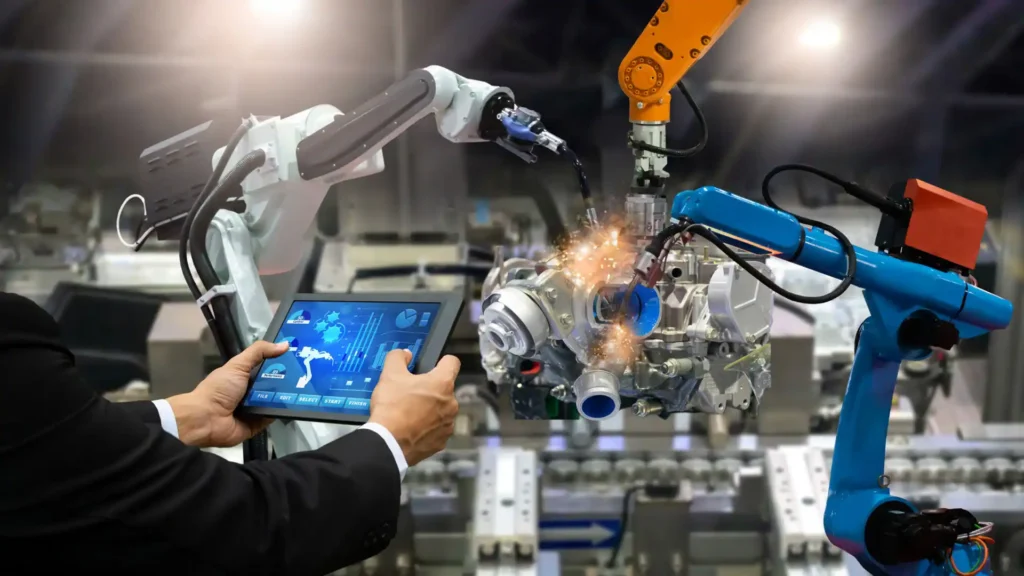In the intricate world of manufacturing, the smallest defects can have significant consequences. Microscopic defects, often invisible to the naked eye, can compromise product integrity, safety, and performance. Traditional inspection methods may not suffice to detect these minuscule imperfections, leading to potential quality control issues. However, advancements in artificial intelligence (AI) are revolutionizing microscopic defect detection, offering unprecedented accuracy and efficiency using Ai driven machine vision systems.
The Importance of Microscopic Defect Detection
Microscopic defects can occur in various forms, including cracks, voids, inclusions, and surface irregularities. Detecting these defects is critical in industries where precision and reliability are paramount, such as:
- Semiconductor Manufacturing: Even the tiniest defect can disrupt the functionality of semiconductor devices, leading to failures in electronic products.
- Aerospace and Defense: Microscopic defects in aerospace components can compromise structural integrity, posing safety risks.
- Medical Devices: Ensuring that medical devices are free from defects is crucial for patient safety and compliance with stringent regulatory standards.
- Automotive Industry: High-quality standards are essential for the performance and safety of automotive parts, necessitating the detection of even the smallest defects.
Traditional Methods of Microscopic Defect Detection
Traditional inspection methods for defect detection include:
- Manual Inspection: Using microscopes, trained inspectors examine products for defects. This method is time-consuming, prone to human error, and not scalable for high-volume production.
- Non-Destructive Testing (NDT): Techniques such as X-ray, ultrasonic, and magnetic particle inspection are used to detect defects without damaging the product. While effective, these methods can be expensive and require specialized equipment and expertise.
- Optical Microscopy: Optical microscopes are used to magnify the product’s surface, allowing inspectors to identify defects. However, this method can be limited by the resolution and field of view.
The Role of AI in Microscopic Defect Detection
Artificial intelligence, particularly through machine learning and deep learning algorithms, is transforming the field of microscopic defect detection. AI-driven systems offer several advantages over traditional methods, providing higher accuracy, consistency, and scalability.
Key Features of AI-Driven Microscopic Defect Detection:
- Advanced Imaging Techniques: AI systems use high-resolution cameras and advanced imaging techniques to capture detailed images of the product’s surface, highlighting microscopic defects that might be missed by traditional methods.
- Deep Learning Algorithms: Deep learning models are trained on large datasets of defect images, enabling them to recognize complex patterns and anomalies with high precision.
- Automated Analysis: AI systems automate the analysis of images, eliminating the need for manual inspection and reducing the risk of human error.
- Real-Time Detection: AI-driven systems can process images in real time, providing immediate feedback and allowing for quick corrective actions.
- Continuous Improvement: AI systems can continuously learn from new data, improving their accuracy and reliability over time.
Applications of AI in Microscopic Defect Detection
- Semiconductor Industry: AI systems inspect wafers and chips for defects at a microscopic level, ensuring the reliability and performance of semiconductor devices.
- Aerospace Manufacturing: AI-driven inspection systems detect microscopic defects in aerospace components, enhancing safety and compliance with industry standards.
- Medical Device Manufacturing: AI inspects medical devices for surface irregularities and structural defects, ensuring patient safety and regulatory compliance.
- Automotive Industry: AI systems detect microscopic defects in automotive parts, ensuring high-quality standards and reducing the risk of failures.
Benefits of AI-Driven Microscopic Defect Detection
- Enhanced Accuracy: AI systems can detect even the smallest defects with high precision, reducing the likelihood of defective products reaching the market.
- Consistency: Automated inspection ensures uniformity and consistency, eliminating the variability associated with manual inspection.
- Increased Efficiency: AI-driven systems can inspect products at high speeds, increasing throughput and reducing inspection time.
- Cost Savings: By reducing the need for manual inspection and minimizing defects, AI systems lower overall production costs.
- Scalability: AI systems can easily scale to accommodate increasing production volumes, ensuring consistent quality control.
- Predictive Maintenance: AI can predict when equipment needs maintenance, preventing unexpected breakdowns and prolonging the lifespan of machinery.
Intelgic’s AI-Driven Microscopic Defect Detection System
Intelgic offers a cutting-edge AI-driven microscopic defect detection system designed to meet the highest standards of precision and reliability. Our system leverages advanced AI algorithms and high-resolution imaging to detect even the most minute defects.
Key Features of Intelgic’s System:
- High-Resolution Imaging: Captures detailed images of the product’s surface, highlighting microscopic defects with exceptional clarity.
- Advanced AI Algorithms: Uses deep learning models trained on extensive datasets to recognize complex patterns and anomalies.
- Real-Time Processing: Provides immediate feedback and allows for quick corrective actions, minimizing downtime and ensuring continuous production.
- Comprehensive Reporting: Generates detailed reports documenting all detected defects and corrective actions, offering valuable insights for continuous improvement.
- Scalability: Easily scales to match production demands, ensuring consistent quality control across all product lines.
Benefits of Choosing Intelgic’s System:
- Unmatched Accuracy: Detects even the smallest defects, ensuring the highest quality standards.
- Increased Efficiency: Automates the inspection process, reducing manual labor and speeding up production.
- Cost Savings: Minimizes rework and waste, lowering overall production costs.
- Enhanced Flexibility: Adapts to various manufacturing environments and product types, providing a versatile solution for quality control.
- Real-Time Monitoring: Provides immediate feedback on SOP adherence, reducing the risk of quality issues.
The integration of AI into microscopic defect detection is revolutionizing quality control in manufacturing. AI-driven systems offer unparalleled accuracy, efficiency, and scalability, ensuring that even the smallest defects are identified and addressed. Intelgic’s AI-driven microscopic defect detection system stands at the forefront of this innovation, providing manufacturers with a powerful tool to enhance product quality and streamline operations. By embracing these advanced technologies, manufacturers can ensure the highest standards of precision and reliability, maintaining a competitive edge in the market.







